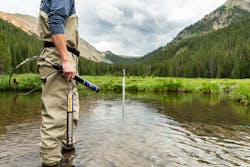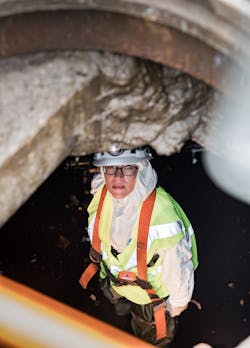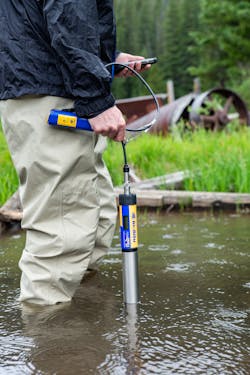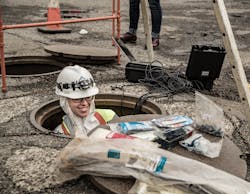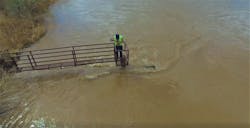When it comes to effective stormwater management, “you can’t fix what you can’t measure” is a pretty accurate adage. Without a monitoring and testing program, it can be challenging for stormwater managers to understand their capacity needs and water quality concerns. And the job is unlikely to get any easier; across the country, companies and state and local governments are looking for savings as the consequences of the COVID-19 pandemic create economic shockwaves around the world.
To better explain the challenges and benefits of implementing a monitoring program, Stormwater reached out to some experts in the field to discuss where the industry is now and where they see it going in the future.
Adam Hobson is a hydrogeologist and applications development manager with In-Situ, a manufacturer of innovative environmental monitoring equipment and remote data collection and data management solutions. Adam has over 20 years of experience addressing water and environmental issues throughout the world. He specializes in the design, planning, and implementation of hydrologic and environmental investigations and feasibility studies, site characterizations, hydrologic monitoring, aquifer testing and analysis, and project management.
Eric Robinson is the application development manager for surface water at In-Situ. For five years, he managed field crews sampling for toxic algae blooms in coastal Florida, and he has worked in the water quality industry for the past 10 years. He holds degrees in environmental science and marketing from FGCU and USF and is currently enrolled at Johns Hopkins.
Stormwater: What are some of the hurdles you see to more widespread monitoring?
Erin Rothman: Cost has been the biggest hurdle to date. Industry-standard sensors can be expensive, and deploying 10, let alone 100, can be cost-prohibitive for most communities. With individuals and startups developing their own IoT devices in recent years, cost is becoming less of an issue; however, now we’re seeing concerns regarding whether the new technology works as well as the incumbents’. And that’s something that will just take some time to prove out. I think most of us realize that hitting a basic standard of performance is absolutely mandatory if we are going to see a shift toward deploying widespread, remote monitoring networks.
Adam Hobson and Eric Robinson: Commonly, we find users telling us that the cost of maintaining hardware in the field and the difficulty of working with large and diverse data sets are the biggest constraints in expanding monitoring systems. Though every organization has unique barriers to expanding their monitoring network, these seem to be commonplace.
SW: What are some misconceptions about testing and monitoring? And what do you see as the largest benefit of a monitoring program?
Rothman: The assumption that it must be expensive is one misconception, although that’s based on historical precedent, so it’s fair. And as I mentioned above, it’s changing. But the benefits! My goodness, there are so many:
Hobson and Robinson: That it is only for large well-funded organizations and that only groups with large science departments can handle it. Monitoring has really changed over the last decade as equipment has become smaller, more affordable, and easier for everyone to use. In the past, the process of monitoring was outsourced by a lot of local and regional organizations because it was seen as being beyond the capabilities of many groups. The thing that really helped move this all forward has been systems’ ease of use really shifting.
Now, effectively anyone that can use a smartphone can take high-quality readings in the field. That, and the dramatically improved reliability of the systems, has allowed for many more groups to do monitoring work internally now. With that, stormwater groups can be much more adaptable around local conditions and make changes to sampling programs on the fly. All this provides for much richer data sets and more developed understandings of what is happening.
SW: What has been the biggest change in stormwater monitoring in the last 10 years?
Rothman: Two things. First, there’s a more widespread recognition now that stormwater has a detrimental impact on aquatic systems and that it’s not necessarily one compound that causes the damage but the combination of compounds, from zinc to nitrogen and everything in between. Also, that it takes far fewer of these compounds, and at a lower concentration, than we expected to damage these systems. So, many regulators are requiring compliance with more stringent requirements, which is good! But also, difficult to keep up with at current costs. Alongside this, I think we’re becoming more aware of the need to monitor continuous flow conditions; measuring 5 milligrams per liter of zinc is fine, but it’s far more helpful to know how many liters you’re dealing with and how frequently. So, putting contaminants in context.
Hobson and Robinson: Really, the monumental shift that is still happening is the scaling down of monitoring sites. As sampling equipment becomes much more efficient and resilient to environmental conditions, monitoring sites themselves can scale down. In the past, every site that supported any autonomous sampling equipment required the installation of large solar arrays, gauge houses, and infrastructure just to measure basic parameters. Modern water quality, flow, and telemetry equipment can now run without all this, not only reducing the cost of installations but allowing for dramatically expanded site availability and less concern about vandalism.
SW: What changes do you expect to see in the next 10 years?
Rothman: System-focused stormwater management. And by system, I mean climate + surface waters + tides + weather + pipes + treatment. Capturing data across cities allows us to truly understand the interactions of each aspect of stormwater management and how they relate. Smart sewers are great! Tying those into the rest of the system is critical.
SW: Are there any challenges or changes to monitoring procedures related to COVID-19?
Rothman: We are seeing more of an emphasis on PPE when working in these systems. You’re side-by-side with your team out there, so making sure we protect ourselves and each other is critical. And with proper PPE and disinfection, I think we’ll be okay. The biggest risk is in combined and sanitary systems, of course, but most of the safety requirements we follow within those systems apply to COVID-19 as well.
Hobson and Robinson: COVID-19 has changed how we all operate. It has forced us to reevaluate what is important and how we achieve the goals that are in front of us as individuals and organizations. Without question, the pandemic has created some real challenges in the process of monitoring, as getting people and equipment to sites is more difficult. One big takeaway here is the proof that telemetry is valuable. Even if technicians are not able to visit a site for standard sampling, in this case, due to health risks, it does not change the requirement to collect samples. Having equipment onsite that can perform these tasks and report back data can keep an organization meeting their requirements without putting their people in harm’s way.
